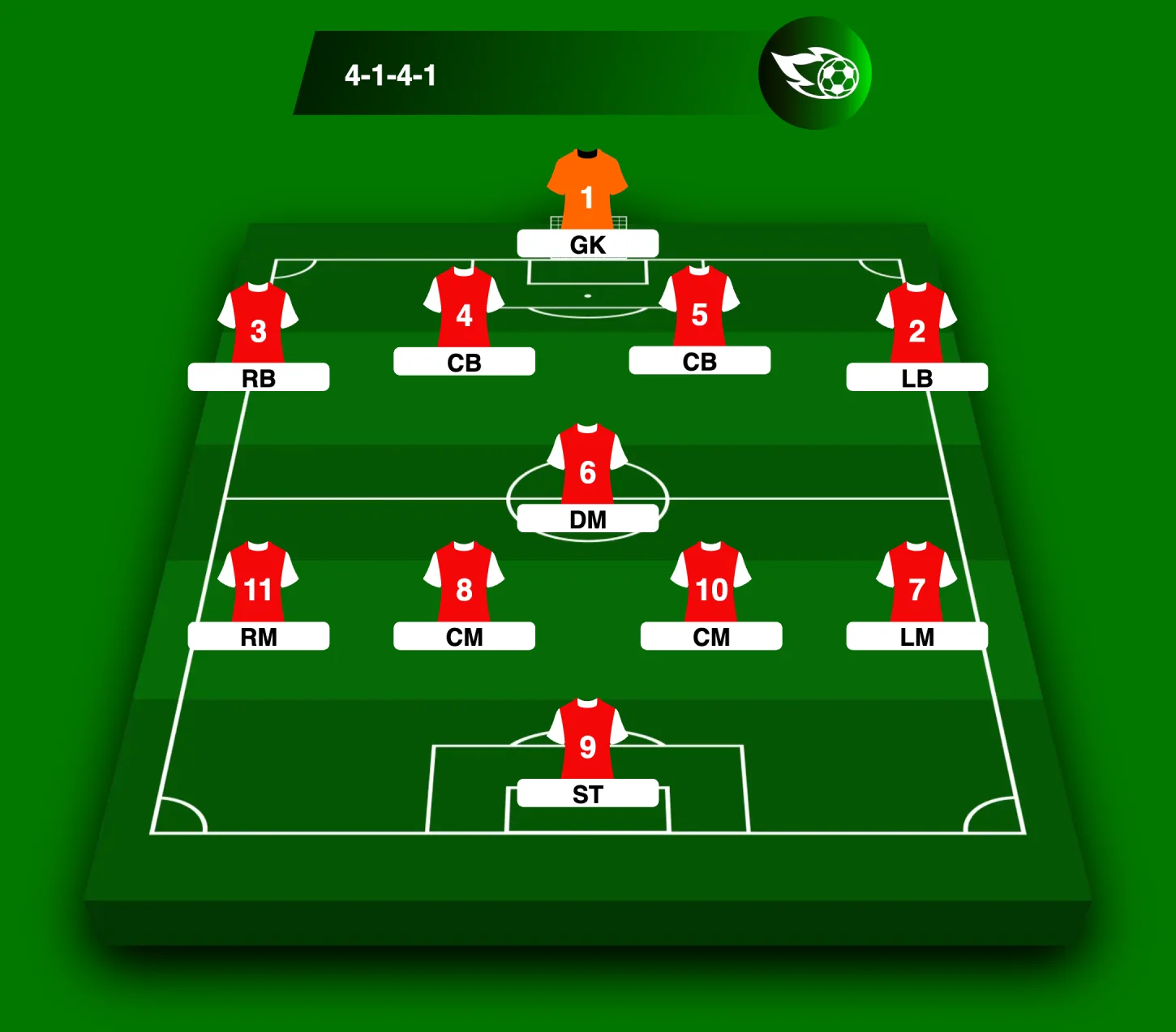Understanding the 4-1-4-1 Football Formation

In football, a team's formation is the blueprint for its strategy, dictating how players position themselves to attack, defend, and control the game. Among the many formations, the 4-1-4-1 stands out for its balance of defensive solidity and midfield dominance. This article explores the 4-1-4-1 formation, breaking down its structure, roles, advantages, disadvantages, and real-world applications to help you understand why it’s a favorite among top managers.
Structure of the 4-1-4-1 Formation
The 4-1-4-1 formation is organized as follows:
- Back Line: Four defenders, consisting of two center-backs and two full-backs.
- Central Defensive Midfielder (CDM): A single "pivot" player who shields the defense and connects play.
- Midfield Line: Four players, including two central midfielders and two wide midfielders.
- Striker: A lone forward who leads the attack and initiates pressing.
This setup is similar to the 4-3-3, where wide players are more attacking, or the 4-5-1, which is more defensive. The 4-1-4-1’s wide midfielders play deeper than wingers in a 4-3-3, staying connected to the midfield and full-backs, offering both width and defensive support.
Roles and Responsibilities
Each position in the 4-1-4-1 has specific duties:
- Defenders: The center-backs provide defensive stability, while full-backs may push forward to support attacks or stay back to maintain structure.
- CDM: Often called the "number six," this player breaks up opposition plays, protects the back four, and distributes the ball to start attacks. Examples include Claude Makelele and Sergio Busquets.
- Central Midfielders: These "number eights" control the game’s tempo, link defense and attack, and provide creative passing. Players like Kevin de Bruyne excel here.
- Wide Midfielders: They offer width, support attacks with crosses or runs, and track back to help defend, unlike the more offensive wingers in a 4-3-3.
- Striker: The lone forward leads the press, holds up play, and scores goals but can become isolated without support. Players like Didier Drogba have thrived in this role.
Advantages of the 4-1-4-1 Formation
The 4-1-4-1 offers several tactical benefits:
- Defensive Solidity: Its central compactness makes it difficult for opponents to penetrate through the middle.
- Midfield Dominance: With three central midfielders (including the CDM) and support from wide players, teams can control possession and dictate the game’s pace.
- Flexibility: The formation can shift to a 4-3-3 when attacking (wide midfielders advance) or a 4-5-1 when defending (midfielders drop back).
- Effective with a Strong CDM: A skilled defensive midfielder, like N’Golo Kanté or Casemiro, can anchor the team, allowing others to push forward.
Disadvantages of the 4-1-4-1 Formation
Despite its strengths, the 4-1-4-1 has weaknesses:
- Lone Striker Isolation: The single forward can be outnumbered by defenders, requiring significant effort to hold up play and score.
- Reliance on CDM: Without a specialist CDM, the defense becomes exposed, as the pivot role is critical.
- Defensive Depth: The formation’s deep positioning can invite pressure, demanding precise passing under duress.
- Reduced Counter-Attacking Output: Wide midfielders often drop back to defend, limiting their contribution to quick transitions.
Tactical Variations and Adaptations
The 4-1-4-1 is highly adaptable:
- Attacking Shift to 4-3-3: Wide midfielders push forward to act as wingers, supporting the striker.
- Defensive 4-5-1 Setup: When protecting a lead, the midfield line drops deeper to form a compact block.
- CDM Flexibility: The defensive midfielder can sit deep to shield the defense or advance to support attacks, depending on the game’s needs.
Tactical concepts like mid-block (defending in the middle third), low block (defending near the goal), and counter-pressing (regaining possession quickly) are often used with this formation to maximize its effectiveness.
Famous Teams and Managers Who Used 4-1-4-1
Several renowned managers and teams have successfully employed the 4-1-4-1:
- Jose Mourinho: At Chelsea (2004-2007), Mourinho used this formation with Claude Makelele as the CDM, supported by Frank Lampard and Didier Drogba, leading to Premier League titles.
- Pep Guardiola: Manchester City has used variations, with Fernandinho or Rodri as the pivot, enabling midfield control and fluid attacks.
- Mikel Arteta: Arsenal has adopted similar setups, with Thomas Partey or Granit Xhaka anchoring the midfield and Martin Odegaard providing creativity.
Key players who have excelled include:
- Claude Makelele: Redefined the CDM role with his defensive intelligence.
- Sergio Busquets: Mastered the pivot role at Barcelona, linking play seamlessly.
- Kevin de Bruyne: Thrives as a central midfielder, creating scoring opportunities.
- N’Golo Kanté: Known for his tireless work rate and ball-winning ability.
Conclusion
The 4-1-4-1 formation is a versatile and effective tactical setup that balances defensive stability with midfield control. Its success hinges on a strong defensive midfielder and cohesive teamwork to support the lone striker. Used by top managers like Jose Mourinho, Pep Guardiola, and Mikel Arteta, the 4-1-4-1 remains a powerful tool in modern football when executed with the right players and strategy. Whether you’re a coach, player, or fan, understanding this formation deepens your appreciation of the beautiful game.
